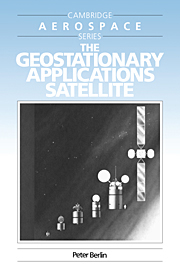Book contents
- Frontmatter
- Contents
- Dedication
- Preface
- List of Acronyms
- 1 Launch vehicles
- 2 The transfer orbit
- 3 The geostationary orbit
- 4 The satellite environment
- 5 Structures
- 6 Mechanisms
- 7 Thermal control
- 8 Power supply and conditioning
- 9 Propulsion and orbit control
- 10 Attitude stabilization, measurement and control
- 11 Telemetry, tracking and command (TT&C)
- 12 Communications payload
- 13 Meteorological payload
- 14 Product assurance
- 15 Spacecraft development and testing
- Index
15 - Spacecraft development and testing
Published online by Cambridge University Press: 02 February 2010
- Frontmatter
- Contents
- Dedication
- Preface
- List of Acronyms
- 1 Launch vehicles
- 2 The transfer orbit
- 3 The geostationary orbit
- 4 The satellite environment
- 5 Structures
- 6 Mechanisms
- 7 Thermal control
- 8 Power supply and conditioning
- 9 Propulsion and orbit control
- 10 Attitude stabilization, measurement and control
- 11 Telemetry, tracking and command (TT&C)
- 12 Communications payload
- 13 Meteorological payload
- 14 Product assurance
- 15 Spacecraft development and testing
- Index
Summary
Introduction
In an ideal world, spacecraft development would begin at the preliminary design stage and stop when the complete design is finalized, the hardware manufactured, and the satellite assembled. The next logical step would be to test the spacecraft in order to ensure compliance with specified performance, establish design and performance margins, and verify that the workmanship has been flawless. The test phase would end after the satellite has been checked out in orbit and is ready to go into service.
Alas, in the real world of spacecraft construction, the sequence of events is not so straightforward. In this chapter we will attempt to steer the reader through a labyrinth of phased development, hardware hierarchy and heritage, model philosophy, assembly, integration and test. For the spacecraft builder, the path is fraught with technical, financial and schedule pitfalls, and his management skills are constantly put to test. The customer, meanwhile, looks nervously over the shoulder of the builder to ensure that no effort is spared to produce a satellite which offers maximum value for money.
Spacecraft Development
Satellites which make use of new technology or particularly complex designs undergo a phased development. By allowing for planned interruptions at well-defined points during the development programme, it is possible to take stock and change the approach without jeopardizing the programme as a whole. Phase A includes mission definition and technical feasibility studies. Phase B covers system design, while Phase C encompasses detailed design finalization and prototype validation.
- Type
- Chapter
- Information
- The Geostationary Applications Satellite , pp. 197 - 209Publisher: Cambridge University PressPrint publication year: 1988



